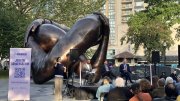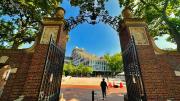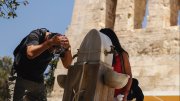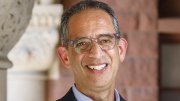Revolution in Cancer Care
I followed Ken Garabadian—the patient who was the focus of “Ken’s Story,” by David G. Nathan (January-February, page 36)—in the STI-571 (Gleevec) clinical trial at Dana-Farber by a few months (I started in February 2001), and so I was quite fascinated and impressed by your excellent and informative article.
 I do want to point out that I, and some other patients with a gastrointestinal stromal tumor (GIST), are important exceptions to a point made in the article that the eventual emergence of drug-resistant tumors is virtually the rule in single-agent chemotherapy like Gleevec. Next month I will celebrate six years on Gleevec, which initially shrank my three tumors 75 percent and has kept them small and stable ever since. Apparently, about 15 percent of this original group still has not shown tumor resistance after five years or more on Gleevec. I remain on the clinical trial at Dana-Farber (in spite of living in North Carolina), which has been continued by Novartis in order to follow this original group of patients that included Ken Garabadian.
I do want to point out that I, and some other patients with a gastrointestinal stromal tumor (GIST), are important exceptions to a point made in the article that the eventual emergence of drug-resistant tumors is virtually the rule in single-agent chemotherapy like Gleevec. Next month I will celebrate six years on Gleevec, which initially shrank my three tumors 75 percent and has kept them small and stable ever since. Apparently, about 15 percent of this original group still has not shown tumor resistance after five years or more on Gleevec. I remain on the clinical trial at Dana-Farber (in spite of living in North Carolina), which has been continued by Novartis in order to follow this original group of patients that included Ken Garabadian.
A final note: back in 2000, I learned about the availability of STI-571 at the Dana-Farber clinical trial via an electronic listserv group of fellow cancer patients. Such patient-caregiver e-mail groups have proven to be a critical means by which patients with rare kinds of cancer find out about new treatment options and clinical trials. Therein lies another good story for your magazine.
Charles D. Korte, Ph.D. ’69
Raleigh, N.C.
In the summer of 1995, quite by accident, it was found that I had chronic myelogenous leukemia (CML). The course of treatment prescribed was massive daily doses of alpha interferon. The treatment was partially successful, but the side effect, for me, was depression. I was morose to the extent that thoughts of suicide came into my head very frequently. This condition had prevailed for about one and a half years when the drug stopped being effective. The depression lifted but the outlook was grim.
One evening in 1996, my wife and I saw on the TV news a report that an experimental drug, STI-571, had had remarkable success in an Oregon program of about 30 patients suffering from CML. Because I had late-stage CML and interferon had stopped being effective, I was a good candidate for a Novartis program in New York and entered it about six months later. In just less than three months, after taking a daily oral dose of Gleevec, I was in total remission and have remained so ever since. I am looking forward to attending my fiftieth class reunion at the Law School in April, an event which seemed very unlikely for me in 1996.
Arthur Kronenberg, J.D. ’57
Hackensack, N.J.
Three cheers for this fascinating article on the frontiers of cancer research. While an undergraduate, I had the good fortune to live with the physician featured in the story, George Demetri. Even then, he had dreams of medical advance: his plan was to discover a contraceptive for men. Sometime during medical school, he found a new calling.
Your article is a testament to the power of ambition in the service of others and the beauty of chasing one’s dreams.
Richard Marks ’78
Brookline, Mass.
Courage, Work, Happiness
“The Science of Happiness,” by Craig Lambert (January-February, page 26), is interesting but incomplete. It is true that the current emphasis on happiness in the profession of psychology is welcome, and reiterates the previous emphasis on humanistic approaches. But happiness is not enough to insure a fulfilling life.
To be fulfilling, happiness must derive from the courage that leads one to face stressful circumstances and do the necessary hard work of transforming them from potential disasters into growth opportunities. Conceptually, courage derives from existential psychology. Empirically, I have developed a measure of courage called hardiness, which combines the three attitudes of commitment (versus alienation), control (versus powerlessness), and challenge (versus threat). More than 600 research studies, done around the world, have shown how these three Cs facilitate growth under stress.
One particularly relevant study by my research team and me showed that hardiness was more effective than optimism (happiness) in helping people cope with stresses by growing through them, rather than stagnating. This showed how happiness, devoid of courage, can be laced with naive complacency. Especially in our turbulent twenty-first century, it is imperative to have courage, not merely happiness.
Salvatore R. Maddi, Ph.D. ’60
Professor, psychology and social behavior
School of Social Ecology
University of California, Irvine
In his excellent article, Lambert explains that today’s positive psychology movement dates back to 1998, but he fails to mention French psychologist Emile Coué (1857-1926) as an early pioneer in the study of positive emotions and thought patterns, an omission for which Coué would surely forgive the magazine with a big smile on his face.
Mark Landesmann, M.B.A. ’89
Palo Alto, Calif.
Kudos to the men and women who work on behalf of positive psychology!
Psychiatry has, for good or not good reasons, reduced individuals to numbers and letters: ICD-9, DSM-IV labels, CPT codes, and GAF estimates. That emphasis on diagnostic nomenclature, combined with increasingly restrictive and often counter-productive pharmaceutical treatments, stymies the potential of psychiatry to help people and impairs the ability of individuals to help themselves. As a profession, we cannot expect more from individuals than we believe is possible for them.
If psychiatry seeks to encourage the potential of the human spirit and wishes to ask individuals to become more than they ever dreamed possible, it must assert a collective consciousness of possibility. That cannot be done by diagnostic reductionism (e.g., when labeling someone as “adolescent with oppositional-defiant disorder” confers the ability to sedate a condition with medication). Neither can it be done by treatment reductionism: half-measured, myopic, and inadequate treatment (e.g., intramuscular naltrexone administered monthly to the alcoholic reduces the extent of his alcoholic drinking, rather than freeing him from the chains of alcoholism that destroy his ability to think and feel). In both cases, reducing an angry adolescent to a diagnostic label or asking less of an alcoholic man by offering him half-measured treatment shortchanges human development. Diagnostic and treatment reductionism significantly limits what a person can do to summon his own cognitive and emotional resources to overcome obstacles and traumas. That limitation, consequently, inhibits creativity, humor, love, and hope, and therefore underscores the urgent need for the message of positive psychologists to succeed.
Stefan P. Kruszewski, M.D. ’77
Harrisburg, Pa.
Daniel Gilbert is quoted thus: “If someone offers you a pill that makes you happy 100 percent of the time, run fast in the opposite direction. Happiness is a place to visit, not a place to live.” Bill Shakespeare wrote, more than 400 years ago, “If all the year were playing holidays,/ To sport would be as tedious as to work;/ But when they seldom come, they wish’d for come.…” So, not exactly news.
Freud is, routinely, dismissed as merely a therapist by modern psychologists who aren’t familiar with Freud’s definition of happiness, or health: the ability to work and love (Arbeit und Liebe). The man wrote voluminously on the art of living, in Moses and Monotheism and Civilization and Its Discontents. And for me, some 46 years after graduation, I look around and see so many of my surviving age peers who have succumbed to the lure of retirement.
It’s not been a matter of my loving my job; I learned to love to work, to be working, to keep trying every day to become a better human being, to solve problems. I can look back on a life wherein I decided early on to avoid worry about money and the cost of things, and so I have always had little enough…and with little enough has come greater pleasure in the occasional small indulgence.
The greatest lesson was discovering that the skills I had to work for are mine forever; the travails of relationships taught me to appreciate les petits bonheurs; and knowing that it will all end some day is a comfort, not a dread. Happiness, like the Tao, cannot be captured; it is not a goal; it comes as a result of one’s right actions and thoughts. It’s how we know that our actions and thoughts were right; to paraphrase Hemingway, what’s right is what feels good afterwards.
Nathaniel Ehrlich ’61
Research specialist, Michigan State University
Institute for Public Policy and Social Research
East Lansing, Mich.
Experiencing Elevator Music
According to Richard Dyer’s review of Daniel Barenboim’s Norton Lectures (“Ideas, Appassionato,” January-February, page 15), Barenboim distinguishes between hearing and listening by saying that we can’t help listening because we don’t have earlids, but “hearing is listening with thought.” This is contrary to what Barenboim says in his earlier, and nearly identical, BBC Reith Lectures. There he says that muzak provides opportunities to hear music without listening to it: “[Y]ou don’t have to concentrate, you don’t have to listen.” So which is it? I think Dyer gets it right later in his review when he has Barenboim describing elevator music as omnipresent but not meant to be listened to.
Charles Courtney, B.D. ’60
Madison, N.J.
Virgil Misdated
The very first sentence of “Iambic Imbroglio” (January-February, page 20) contains an error. Virgil died in 19 b.c., not A.D. 19 as stated. Had Virgil died in A.D. 19, Augustus would not have been around (he died in A.D. 14) to overrule Virgil’s instruction that the Aeneid be destroyed.
David Burzillo, A.L.M. ’92
Natick, Mass.
Learn. Connect. Access. A New, More Useful Website
This website has just been thoroughly redesigned to serve you better.
If you want the latest news about Harvard, you will find editorially independent reporting in the website’s Breaking News space.
If you want to find that article you read some years back on exercise, animal research, ROTC, pyramid builders, diet dangers, globalization, art fakes, or mosquitoes, it’s all there, it will continue to be there, and we hope we’ve just made it easier for you to relocate it. Many visitors to the site come in search of information about issues that concern them. One of our goals is to help in that pursuit of knowledge.
If you want to tell us that your address has changed, send us news about yourself for class notes, submit an arresting letter to the editor for publication, or securely make a donation to support the enterprise (which remains dependent on your contributions), the new website makes all this easy to do. And please tell us what you think of the site: you’ll find a survey on-line.
~The Editors
The Opposite of “If”
“The College Pump” (September-October 2006, page 92) asks, “What is the opposite of ‘if’?” and numerous readers answer (“Letters,” November-December 2006, page 106). The only possible answer is “when.” “When” does away with all the conditionality that both “if” and “unless” have. It’s a true opposite. “Unless” is more of an obverse than a converse, to go back to Aristotelian logic.
Jack Rafuse
Alexandria, Va.
“If there is nothing left to discuss, the matter is closed.”
“As there is nothing left to discuss, the matter is closed.”
Davia J. Lu ’73
Folsom, Calif.
Expanding on The Game
Congratulations on the informative, balanced, and statistically rich article on the 2006 football season, “Who Let the Dogs Out?” (January-February, page 74). One omission in the otherwise meticulously documented piece puzzled me, however. The author mentions Robert Fisher’s illustrious 1919-22 teams, and even goes back to pre-World War I days to make a wonderful comment about the 1912 football season and the U.S. presidential election that year. Yet regarding the history of The Game itself, we are only told that “Yale trails, 26-24-1, in games played since the formalization of Ivy League competition in 1956.” As a Harvard-educated historian, I recoil at any attempt to expunge more than one-half of The Game’s contests from the record. A check with Google quickly revealed the full story: Yale leads the series 65-50-8.
Michael Haltzel, Ph.D. ’71 (Yale ’63)
Alexandria, Va.
Clarifications
The caption to the photograph of Michael Burke’s sculpture The Neutrino Chronicles on page 81 of the January-February issue implies that the photograph shows the piece’s initial placement in an Etruscan tomb. In fact, the sculpture is shown installed in Santa Maria della Salute in Viterbo.
In “Hello, Geotech” (November-December 2006), the left and right graphics with legends on page 50, referring to a study of urban bus retrofits, were reversed in error.
Dawson, Marinaro: Compare and Contrast
We at Cornell congratulate Clifton Dawson (“Dawson by the Numbers,” January-February, page 75) on his outstanding career as a running back on the Harvard football team, including his surpassing of our Ed Marinaro as the record-holder for Ivy League career rushing yards. By any measure, Dawson was a truly outstanding student-athlete and a supreme competitor.
That said, I feel obliged to point out that Dawson’s 4,841 yards were accumulated in four full seasons of varsity football, a total of 40 games, for an average of 121 yards gained per game. When Marinaro played at Cornell (1968-71), freshmen were not allowed to play varsity football and the varsity season had just nine games. Thus Marinaro gained his 4,715 yards in only 27 games, for an average of 175 yards per game.
Ed, of course, went on to play Officer Joe Coffey on Hill Street Blues. But that’s another story.
James Roberts
Editor and publisher
Cornell Alumni Magazine
Ithaca, N.Y.
Editor’s note: Though Marinaro played just three seasons of varsity football, the two running backs reached the 4,715-yard mark with an almost identical number of rushing attempts—918 for Marinaro, 920 for Dawson.
Corrigendum: Four of Dawson’s 66 career touchdowns—not seven, as stated on page 75 of the January-February issue—came on pass receptions.
Trinity Squash
It is disconcerting when ugly manifestations of an outside world erupt into the consciousness of Harvard University (and its magazine). But, please, strive to maintain a stiff upper lip on those rare occasions. The magazine’s coverage of Harvard’s exemplary squash captains in the January-February issue (“Forecourt Phenoms,” by Craig Lambert, page 77) veered into churlishness in its first paragraph. After a little reflexive chest thumping about Harvard’s 30 national squash titles, you were obliged to take note of the fact that Trinity College has shattered the order of nature by winning the past eight consecutive national men’s team titles. Such temerity demands an explanation and your writer observed that little Trinity had, around 1997, “decided to build a powerhouse squash team with global recruiting, January admits, and strong coaching.”
Since just about every intercollegiate player named in the article, including both of Harvard’s current captains and Princeton’s vaunted Yasser El Haleby, is not a U.S. national, one might reasonably conclude that global recruiting is not practiced exclusively at Trinity. Neither, presumably, is “strong coaching.” Those diabolical January admits must be to blame.
Here in Hartford, well below the radar, we cheerfully admit that sooner or later Trinity’s unparalleled unbeaten streak will end. We’re just enjoying the ride. But perhaps even Harvard Magazine can summon a word of praise for an unlikely rival’s accomplishments, rather than trying to explain them away.
I’d advise you to cast an occasional glance over your shoulder. Trinity has Harvard in its sights. All it needs is about $25 billion and a few more January admits.
Andrew Walsh, Ph.D. ’96 (Trinity ’79)
Hartford, Conn.
Craig Lambert replies: Yes, it is those diabolical January admits. Alone among the eight colleges that compete for the College Squash Association’s national title, Trinity has made what amounts to an annual practice out of January admits—including this year, for example. International recruiting has of course long been widely practiced in most intercollegiate sports, though Trinity has perfected the art to such a degree that a North American player is an anomaly on their men’s traveling squad. Our article’s first paragraph declares that “Trinity has not lost a men’s squash match in eight years, the longest such streak in the sport’s history,” apparently damning the Bantams with faint praise.
Speak up, Please
Harvard Magazine welcomes letters on its contents. Please write to “Letters,” Harvard Magazine, 7 Ware Street, Cambridge 02138, send comments by e-mail to yourturn@harvard.edu, use our website, www.harvardmagazine.com, or fax us at 617-495-0324. Letters may be edited to fit the available space.





